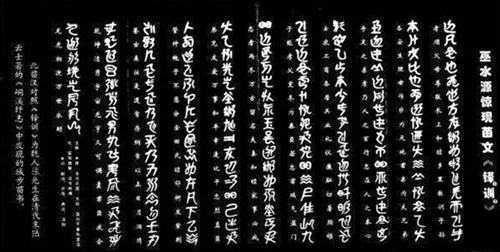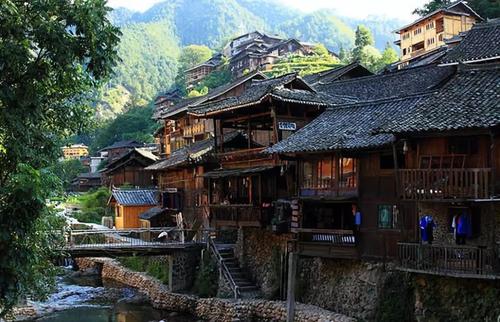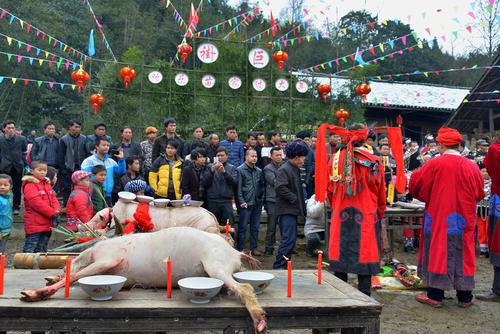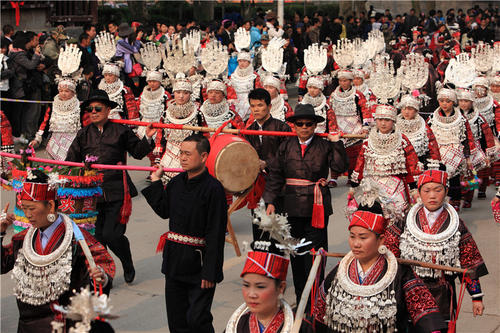
The Miao group is the fifth largest one among 56 official ethnic groups in China. According to the 2010 China’s census, the population of Miao people was about 9.42 million, accounting for over 70% of all Miao people in the world. Miao people primarily settle in China’s provinces of Guizhou, Hunan and Yunnan, among which Guizhou Province has the largest Miao population of around 4.3 million, nearly half of the total Miao population in China. Some of them are also scattered in other places with other ethnic groups. The Miao Minority originated in China and mainly live in southern China as well as Southeast Asia, where they are generally called Hmong. It is also worth mentioning that some of the Miao people also emigrated out of Asia into several Western nations, including the United States, France and Australia. Approximately, there are 260,000 Hmong Americans in the United States. Most of them emigrated to the US as refugees in 1975, at the end of the Vietnam war.
“Miao” became the official name of this ethnic group in 1949, including a few ethnic minority groups that are related to each other in terms of language. In Chinese history, this term meant non-Han Chinese groups and referred to the ethnic groups who had not become assimilated into the Han nationality. As a matter of fact, it has a derogatory connotation of “barbarian”. Therefore, the Miao people traditionally called themselves “Hmub”, “Hmongb”, “Hmaob” and “maob” in some areas, all of these are Miao language. However, in modern China, the term Miao is not used in that derogatory way. So, it is accepted that they continue to be classified as “Miao” people by the government.
According to ancient Chinese legends, the Miao people are descendants of Chi You, who was defeated by Yan Di and Huang Di at the battle of Zhuolu. Also, the Miao people firmly believe that they descended from Chi You. However, no evidence proves that Chi You was the ancestor of the Miao people.

According to some scholars, the ancestors of the Miao people are Miao-Man tribes (a variation of Nanman, which means Southern Barbarians) who are located in the Yangtze River valley, especially the Middle-Lower Yangtze Plain. In Miao’s history, they have experienced several great migrations to the south and west, and they also had a long period of primitive society. They used leaves as clothes, treated caves as homes, and were led by female leaders. But, after Qin and Han Dynasties, counties were established in most Miao areas under the control of the central government. At the same time, the introduction of ironware and other production technologies from the Han people promoted the Miao economy, but their productivity still remained low for a long time.
The Miao people have experienced serious difficulties, who had a tenacious struggle against the oppression. To resist the ruling class in the past, they have repeatedly carried out large-scale armed uprisings. But, after the founding of the People’s Republic of China, various Miao autonomous prefectures and counties were established, thereby achieving ethnic equality in China.

In China, the Miao people are scattered throughout the country, while they live in the individual compact community in small areas. There are also many Miao people residing in Southeast Asian countries, like Vietnam, Myanmar, Laos and Thailand. The Miao people in Southeast Asia, as refugees, migrated out of Southeast Asia into many western countries during the Vietnam War. In the late 1970s, when a large number of Miao people migrated into the United States, many of them also came to France, Canada, Australia and other countries. Among them, there were about 11,500 in France, 1,000 in Canada, and over 15,000 in Australia. With the help of local government, most of these overseas Miao people have built schools to teach their children the Miao language.

There are three major branches of the Miao language. Although some differences do exist, the mutually intelligible part still accounts for more than 60%. Miao languages in different regions have different characteristics, but usually, the more immense the influence of the Han nationality culture is, the more Chinese words are used.
The Miao people used to have writing systems. Some ancient Miao folks record that lots of books were lost in the river while their ancestors escaped from wars. When few Miao intellectuals in the tribe passed away, their written language also failed to be handed down.
In the 20th century, some Miao intellectuals created some scripts and compiled Miao teaching materials for the development of their culture and education. Some foreign missionaries also helped to create writing systems for the Miao people. However, none of these was successfully promoted among the Miao people. Nowadays, most Miao people in China use Chinese characters; in Southeast Asia, their scripts in use, which a Christian missionary created, are Romanized alphabets.

Most of the Miao people believe in animism, and their belief system is extremely complicated. One of their religious characteristics is that it has complicated rituals, in which you might find any one of the ancient ones that also were performed in other cultures.
The Miao customs are complicated, but It still can form a system under difficult living conditions. The Miao customary law that maintains life order within their group is very complete, in which solutions to any life contradictions can be found. In the absence of written language, these customary laws have been passed down orally to maintain the stability of small-scale groups for a long time, which is the reason why the Miao people have kept their own customs in seclusion.

But at the same time, it takes a large amount of time and money to maintain these customs and to pass them down from father to son for generations. For example, a traditional costume of a Miao girl is the consumption of time and money, not to mention those complicated religious rituals. These would not provide much help for tribes like the Miao who take primitive agricultural production as their main means of survival.
The Miao colorful costumes have many styles. There are more than one hundred clothing styles for Miao women, which outnumber other ethnic groups’. Dozens of headgear are decorated for only one outfit. However, the male costumes of the Miao people are relatively simple.

Among rich Miao music styles, folk songs and Lusheng tunes are the most common ones. Lusheng is a Miao musical instrument made of bamboo and hardwood. It has five or six pipes in a variety of sizes ranging from quite small to several meters in length. Performers usually dance from side to side while they are playing the Lusheng.
According to their contents, the Miao folk songs, with different melodies, fall into several categories, such as love songs, toasting songs, children songs and songs for funeral or labor. The lyrics of these various folk songs are both traditional and improvised and usually based on real stories. Pange, the most interesting Miao folk song, is an ancient antiphonal singing style for young Miao people to express their wishes. Generally, a lad starts the Pange, and a girl answers. If both of them have feelings for each other while singing in turn, they may get engaged. And then, the girl’s parents would like to toast the love of the couple with a ram-horn cup of homemade alcohol. At last, all participants will dance to congratulate this new couple while performing the Lusheng.

The recreational collective singing and dancing of young Miao men and women are accompanied on the Lusheng, so it is also called Lusheng Dance. It is a traditional Miao custom that men play the Lusheng while women dance to the music. If a young Miao lad not only plays the Lusheng well, but also masters dance moves with special skills, then he will become the superstar among others and acquire more unmarried girl’s favor. Although these young men and women are not professional dancers, their dancing style is simple yet graceful and exudes heartfelt joy, thereby attracting audiences to swing to and fro.
Due to the special migration history, the Miao people have formed their own unique style in the material selection and construction of their buildings. They prefer three-story wooden buildings. To deal with uneven terrain, the first floor is generally a half-side room, where a few odds and ends would be kept or the livestock is raised. The second floor is for people to live in, while the third floor stores food. Some would like to set up a platform on the third floor for their young girls to find young boys and also show their beauty in order to establish a preliminary relationship with young lads.

The Miao embroidery has a long history. It is the main decoration of the Miao costumes and also a typical cultural symbol. Although the Miao embroidery patterns are abundant, the popular ones are relatively fixed, including Chinese dragons, birds, fish, flowers, butterflies, and historical stories. Their embroidered costumes could be both single color and multiple colors.
The Miao people also apply batik to their traditional costumes. According to the Miao custom, all women are obliged to pass on the batik, and every mother must teach her daughter how to practice the batik making process. Therefore, the Miao women have learned this technique since their childhood. Miao batik products are mainly daily necessities, including clothing, bedsheets, headscarves, packs and straps.
The Miao ethnic festivals are very attractive, among which the Miao New Year, the Lusheng Festival and the Sister’s Meal Festival are regarded as the most significant and grand festivals.

The Miao New Year’s day is different from the Chinese Spring Festival. It is in either the ninth or the tenth month of the lunar calendar. Although it is not fixed each year, the exact date will be announced around two months prior to festivities. Tourists, who are visiting here during the New Year Festival, will have a chance to enjoy beautiful Miao girls in gorgeous traditional clothes, the best homemade spirits, and various attractive shows, including horse racing and bullfighting.
The Lusheng Festival is an influential festival of the Miao group, featuring dancing to the music of the Lusheng. It is observed from the 16th to 20th day of the first month according to the Chinese lunar calendar. It could be considered as the grandest festival among the Miao people, because almost all the Miao people from surrounding villages would gather together during the festival. Women would like to wear their most beautiful traditional costume and precious silver headdresses, and dance to the rhythm of the Lusheng played by men. Its main purpose is to worship ancestors and celebrate a good harvest. Join their dancing circles if you happen to visit the Miao areas during this festival.

The Sister’s Meal Festival is celebrated on the 15th day of the third month in the Chinese lunar calendar, which is April in Gregorian calendar. Miao girls usually dye glutinous rice with wildflowers and leaves they collect prior to the celebration. This colored steamed rice, called “sister’s rice” is dyed blue, pink, yellow and white to represent spring, summer, autumn and winter respectively. Then, girls will bring their rice to the bank of river to wait for boys’ arrival. A boy will sing a song to the girl he adores. If this girl responds to this song and offers him a cup of colored rice with a pair of red chopsticks, it means this girl accepts the boy’s affection. This courtship ritual is the main part and purpose of this festival.
The Miao people’s diet has its own characteristics. The staple food is rice as well as other coarse cereals including corn, sweet potato and millet. Their main sources of protein are domestic livestock, poultry and fish. A spicy-and-sour taste is indispensable in the normal life of the Miao people, for lack of salt in mountainous areas.
Please kindly always keep the following taboos in mind during your trip to Miao areas. Do not stand right in the middle of newlyweds. Do not sit in the place where they worship their ancestors. Do not whistle in the house or at night. The Miao area is a wonderful place where you will easily enjoy varied and colorful activities as long as you do not violate any of their taboos.
